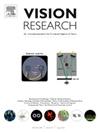非重叠视野缺陷的视觉功能:模拟暗斑的健康受试者的二分实验
IF 1.4
4区 心理学
Q4 NEUROSCIENCES
引用次数: 0
摘要
在临床护理中,只要至少有一只眼睛能正常看到每个视觉空间点,就通常认为青光眼患者视力正常。最近的研究挑战了这一假设。在青光眼中,视觉感知空间碎片化的双眼输入可能被长期的神经适应和急性感觉效应改变。这两种成分在青光眼患者中不容易分离,但后一种成分可以通过模拟健康人的视野缺陷分离出来。因此,本研究的目的是发现模拟的非重叠视野缺陷(NOVFDs)是否会妨碍健康受试者的某些视觉感知。我们在这项横断面观察性研究中纳入了10名健康受试者。受试者进行了针对对比敏感度、运动感知(线运动和连贯点运动)和形状识别的心理物理实验。实验使用立体镜在三种不同的观察条件下进行:(1)双目,(2)模拟novfd,(3)单眼。与双目观看条件相比,novfd观看条件导致视觉感知的所有测试方面的性能下降。与单目观看条件相比,novfd观看条件导致形状识别性能较差。在这两种观看条件之间没有观察到其他差异。我们的研究结果表明,模拟的novfd损害了某些视觉功能。这有助于对健康受试者视觉感知的基本理解,并作为理解青光眼患者疾病分期与视觉问题之间关系的第一步。本文章由计算机程序翻译,如有差异,请以英文原文为准。
Visual functions in non-overlapping visual field defects: dichoptic experiments in healthy subjects with simulated scotomas
In clinical care, glaucoma patients are often assumed to have normal vision as long as each point of visual space is seen normally by at least one eye. Recent studies have challenged this assumption. In glaucoma, visual perception of spatially fragmented binocular input may be altered by long-term neural adaptation and by acute sensory effects. These two components cannot be disentangled easily in glaucoma patients, but the latter component can be isolated with simulated visual field defects in healthy subjects. Therefore, the aim of this study was to find out if simulated non-overlapping visual field defects (NOVFDs) can hamper certain aspects of visual perception in healthy subjects. We included 10 healthy subjects in this cross-sectional, observational study. Subjects underwent psychophysical experiments targeting contrast sensitivity, motion perception (line motion and coherent dot motion), and shape recognition. Experiments were done in three different viewing conditions using a stereoscope: (1) binocularly, (2) with simulated NOVFDs, and (3) monocularly. The NOVFDs viewing condition resulted in a decreased performance across all tested aspects of visual perception, when compared to the binocular viewing condition. The NOVFDs viewing condition resulted in a poorer performance in shape recognition compared to the monocular viewing condition. No other differences were observed between these two viewing conditions. Our results show that simulated NOVFDs impair certain visual functions. This contributes to the basic understanding of visual perception in healthy subjects and acts as a first step in the understanding of the relationship between disease stage and the visual problems that glaucoma patients may experience.
求助全文
通过发布文献求助,成功后即可免费获取论文全文。
去求助
来源期刊

Vision Research
医学-神经科学
CiteScore
3.70
自引率
16.70%
发文量
111
审稿时长
66 days
期刊介绍:
Vision Research is a journal devoted to the functional aspects of human, vertebrate and invertebrate vision and publishes experimental and observational studies, reviews, and theoretical and computational analyses. Vision Research also publishes clinical studies relevant to normal visual function and basic research relevant to visual dysfunction or its clinical investigation. Functional aspects of vision is interpreted broadly, ranging from molecular and cellular function to perception and behavior. Detailed descriptions are encouraged but enough introductory background should be included for non-specialists. Theoretical and computational papers should give a sense of order to the facts or point to new verifiable observations. Papers dealing with questions in the history of vision science should stress the development of ideas in the field.
 求助内容:
求助内容: 应助结果提醒方式:
应助结果提醒方式:


